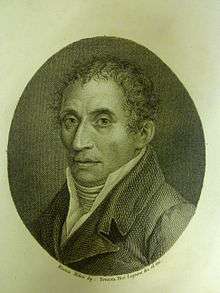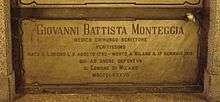Giovanni Battista Monteggia
Giovanni Battista Monteggia (1762 – 1815) was an Italian surgeon.[1] The Monteggia fracture is named after him.
Giovanni Battista Monteggia | |
|---|---|
 | |
| Born | 8 August 1762 Laveno, Italy |
| Died | 17 January 1815 (aged 52) Milan, Italy |
| Nationality | Italian |
| Years active | 1788-1815 |
| Known for | Monteggia fracture |
| Medical career | |
| Profession | surgeon |
| Field | surgery, traumatology |
Biography
He began training as a surgeon at age seventeen in Milan. He got his doctorate of medicine in 1789 at University of Pavia. In the same year, his first book, Fasciculi Pathologici, was published. From 1790 he practiced as a surgical assistant, prosector, and prison doctor. In 1795 he was appointed professor of anatomy and surgery, holding a chair of Istituzioni Chirurgiche at University of Pavia. He contracted syphilis after cutting himself during an autopsy.

Monteggia was second to describe the Monteggia fracture, a fracture of the proximal third of the ulna with the dislocation of the head of radius.
Monteggia was first to describe Peroneal Tendon Subluxation, when he diagnosed this injury in a ballet dancer in 1803. It is when you have subluxation/dislocation of the peroneal tendons about the lateral malleolus.